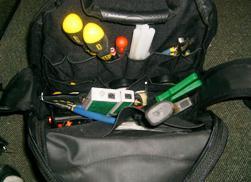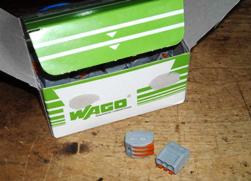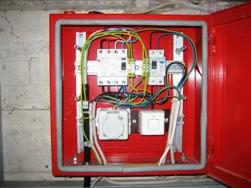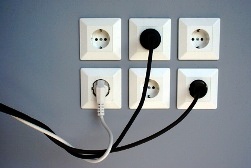 The article provides lighting control circuits using walk-through and cross switches, bistable relays, dimmers, dimmers, photorelay, timers and infrared motion sensors.
The article provides lighting control circuits using walk-through and cross switches, bistable relays, dimmers, dimmers, photorelay, timers and infrared motion sensors.
Lighting control schemes have already been repeatedly considered in the literature and on the pages of various Internet sites of electrical orientation. Therefore, here we will try to outline the various existing solutions.
The simplest control schemes for a one- or two-key switch are known to everyone and, therefore, few people are interested, so we will immediately proceed to consider lighting control schemes from several places.
Let's start with a specific simple situation - let's say you have two floors in a country house. In the evening you climb the stairs to the second floor. Naturally, you need to turn on the lights on the stairs. Turn on on the ground floor. We rise to the second floor...
How to choose a voltage stabilizer for a country house
 The time has long passed when the voltage in the network was more or less stable, and amounted to 220 V + - 3-5%. In the realities of today's life.
The time has long passed when the voltage in the network was more or less stable, and amounted to 220 V + - 3-5%. In the realities of today's life.
The voltage, depending on the region of residence, can fluctuate in very large limits. Anyone who is even a little familiar with electrical networks knows that the further the facility, in this case your house, is from the transformer substation, the greater the voltage drop.
For most electrical appliances, both overstated and underestimated voltages are dangerous; many electrical appliances will simply not turn on or fail. Only devices capable of regulating voltage can help in this situation. Such devices are called voltage stabilizers ...
Wiring in the attics and basements
 Long gone are the days when basements and attics were left empty or, in the best case, used them as technical rooms where various communications were installed - sewage, ventilation, heating.
Long gone are the days when basements and attics were left empty or, in the best case, used them as technical rooms where various communications were installed - sewage, ventilation, heating.
But all the same, there are situations when it is necessary to install wiring in the attics, in basements, cellars. In this article we will try to figure out how to properly install the wiring.
So, before you begin installation, it is necessary to determine what type of premises the basement and attic belong to. Let's start with the basement. Basements belong to rooms with high humidity, therefore, to the wiring in this case, increased demands are made ...
 Quite often you have to observe the work of electricians, who, how and with what tool works. And sometimes you see a woe-electrician with a tool that can only, except that, hammer nails and poke around the walls ... After all, electricians are the intelligentsia among builders, white bone, so to speak ...
Quite often you have to observe the work of electricians, who, how and with what tool works. And sometimes you see a woe-electrician with a tool that can only, except that, hammer nails and poke around the walls ... After all, electricians are the intelligentsia among builders, white bone, so to speak ...
In this article, we will try to “assemble” an electrician’s suitcase, which we will equip with the most necessary electric installation tool that every self-respecting electrician uses in everyday practice.
So, the choice of an electrical installation tool for work is purely individual, but there is a universal set that is necessary for daily work. The following tools can be safely added to this set ...
How to connect copper and aluminum wires
 It's no secret that it is not recommended to connect copper and aluminum wires. But many, even knowing this, still neglect it, hoping for the Russian "maybe it will pass."
It's no secret that it is not recommended to connect copper and aluminum wires. But many, even knowing this, still neglect it, hoping for the Russian "maybe it will pass."
As a result, such a twist of a pair of copper-aluminum will live very briefly. And if the connection is on the street or in a room with high humidity, then the life span of such a pair is several times shorter.
But quite often, situations arise when we need to connect copper and aluminum wiring. Often this situation occurs when repairing electrical wiring in houses where aluminum wiring is laid ...
Pulse relays for lighting control and their use
 Often, one switch is not enough to control the lighting, for example, when you need to turn on the light at the beginning of a long corridor and turn it off when you reach the end. This is realized by installing pass-through switches, quite simply, you just need to lay a three-core cable between them. But if you need to implement lighting control from more places, there are difficulties with laying wires to the cross circuit breakers, their connection ... It is much easier to use a special relay in such schemes. In this article we will consider what a pulse relay is and how to work with it.
Often, one switch is not enough to control the lighting, for example, when you need to turn on the light at the beginning of a long corridor and turn it off when you reach the end. This is realized by installing pass-through switches, quite simply, you just need to lay a three-core cable between them. But if you need to implement lighting control from more places, there are difficulties with laying wires to the cross circuit breakers, their connection ... It is much easier to use a special relay in such schemes. In this article we will consider what a pulse relay is and how to work with it.
Conventional relays work simply when voltage is applied to the coil - the contacts close (or open), when not, they return to their original position. In pulse relays, or as they are also called - bistable - this is not the case. When a voltage pulse is applied to the relay, it turns on; when the next pulse is applied, it turns off. Conventional bistable relays are used in automation and security systems, when applying a pulse of the same polarity ...
 Electrical shield…. What is it? This is the beginning of the entire electrical part of the building, and it doesn’t matter if it’s a huge factory in a metropolis or a modest grandmother’s house in the village. Everywhere there is an electric shield.
Electrical shield…. What is it? This is the beginning of the entire electrical part of the building, and it doesn’t matter if it’s a huge factory in a metropolis or a modest grandmother’s house in the village. Everywhere there is an electric shield.
In this article we will get acquainted with the most common electrical panels that can be found in everyday life. For example, take the most ordinary apartment building.
So where does the electrical part of the house begin? Depending on the project, on the power that is supplied to the house, the electrical part begins with an electrical panel. In the switchboard there can be a switchgear (input-distribution device) or main switchboard (main switchboard). It is to these installations that power cables from a transformer substation (TP) come ...
Placement of sockets and switches
 How and where is the best place for sockets and switches.
How and where is the best place for sockets and switches.
Everyone, sooner or later, thinks about repairing a house, an apartment. When planning a repair, the question arises about the location of sockets, switches, lamps. As a rule, during repair, the old wiring is completely replaced with a new one. In this article, we will consider options for the most optimal placement of sockets and switches.
There are no uniform rules, standards and formulas for determining the number of outlets. Each apartment, each house with its inhabitants is individual and requires an individual approach to determining places for the location of sockets, switches ...
